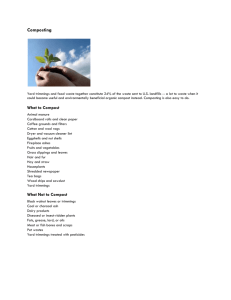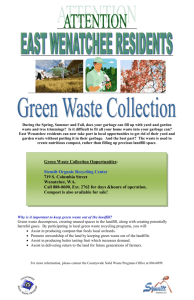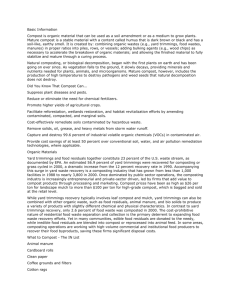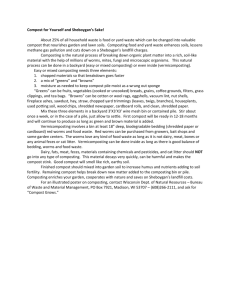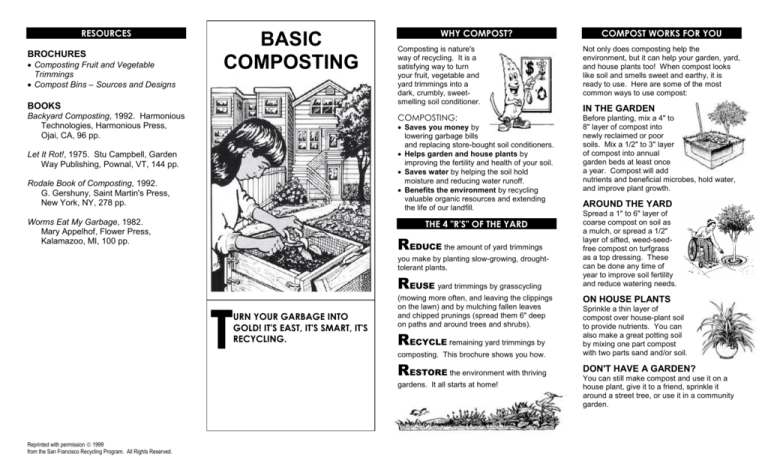
RESOURCES
BROCHURES
Composting Fruit and Vegetable
Trimmings
Compost Bins – Sources and Designs
BASIC
COMPOSTING
BOOKS
Backyard Composting, 1992. Harmonious
Technologies, Harmonious Press,
Ojai, CA, 96 pp.
WHY COMPOST?
Composting is nature's
way of recycling. It is a
satisfying way to turn
your fruit, vegetable and
yard trimmings into a
dark, crumbly, sweetsmelling soil conditioner.
Not only does composting help the
environment, but it can help your garden, yard,
and house plants too! When compost looks
like soil and smells sweet and earthy, it is
ready to use. Here are some of the most
common ways to use compost:
COMPOSTING:
Before planting, mix a 4" to
8" layer of compost into
newly reclaimed or poor
soils. Mix a 1/2" to 3" layer
of compost into annual
garden beds at least once
a year. Compost will add
nutrients and beneficial microbes, hold water,
and improve plant growth.
Saves you money by
lowering garbage bills
and replacing store-bought soil conditioners.
Helps garden and house plants by
improving the fertility and health of your soil.
Saves water by helping the soil hold
moisture and reducing water runoff.
Benefits the environment by recycling
valuable organic resources and extending
the life of our landfill.
Let It Rot!, 1975. Stu Campbell, Garden
Way Publishing, Pownal, VT, 144 pp.
Rodale Book of Composting, 1992.
G. Gershuny, Saint Martin's Press,
New York, NY, 278 pp.
THE 4 "R'S" OF THE YARD
Worms Eat My Garbage, 1982.
Mary Appelhof, Flower Press,
Kalamazoo, MI, 100 pp.
REDUCE the amount of yard trimmings
you make by planting slow-growing, droughttolerant plants.
REUSE yard trimmings by grasscycling
T
URN YOUR GARBAGE INTO
GOLD! IT'S EAST, IT'S SMART, IT'S
RECYCLING.
(mowing more often, and leaving the clippings
on the lawn) and by mulching fallen leaves
and chipped prunings (spread them 6" deep
on paths and around trees and shrubs).
RECYCLE remaining yard trimmings by
composting. This brochure shows you how.
RESTORE the environment with thriving
gardens. It all starts at home!
Reprinted with permission 1999
from the San Francisco Recycling Program. All Rights Reserved.
COMPOST WORKS FOR YOU
IN THE GARDEN
AROUND THE YARD
Spread a 1" to 6" layer of
coarse compost on soil as
a mulch, or spread a 1/2"
layer of sifted, weed-seedfree compost on turfgrass
as a top dressing. These
can be done any time of
year to improve soil fertility
and reduce watering needs.
ON HOUSE PLANTS
Sprinkle a thin layer of
compost over house-plant soil
to provide nutrients. You can
also make a great potting soil
by mixing one part compost
with two parts sand and/or soil.
DON'T HAVE A GARDEN?
You can still make compost and use it on a
house plant, give it to a friend, sprinkle it
around a street tree, or use it in a community
garden.
CHOOSE A SYSTEM
SYSTEMS FOR FOOD AND YARD
TRIMMINGS
RODENT-RESISTANT BINS
For fruit, vegetable and yard
trimmings (using "Mixed"
compost recipe)
For yard trimmings alone (using
"No-Fuss" recipe)
Bins require a lid, floor and no holes bigger
than 1/4"
OPEN PILES & SIMPLE BINS
For yard trimmings ONLY
Requires "Active" composting
(chopping and weekly turning to
keep animals out)
Usually inexpensive or free
SYSTEMS FOR JUST FOOD TRIMMINGS
For more information about the following, see the
Composting Fruit & Vegetable Trimmings brochure.
FOLLOW THE BASICS
Thanks to friendly bugs and worms, composting
is as easy as "1-2-3"—no matter which recipe
you use!
1 CHOP materials if you want them to break down
more quickly.
2 MIX "browns" (dry, woody materials) with "greens"
(moist, green materials).
F or yard trimmings ONLY. Requires a rodent-
Browns, Greens, Air and Water are the "big
resistant bin to prevent animal nesting.
four" that will keep every compost pile happy.
I N GREDIEN TS:
DO COMPOST:
Most sawdusts
Chopped,
woody prunings
Pine needles
Fallen leaves
Tea bags
Citrus rinds
Closed-Air Systems
Low maintenance
Lawn clippings &
young weeds
Fruit & vegetable
trimmings
Herbivore manures
Requires digging a hole each
time you add new materials
No harvesting necessary
REMEMBER...Whenever you compost fruit
and vegetable trimmings, the Health Department
requires a rodent-resistant system. Use a
container with a lid, a floor, and no holes bigger
than 1/4 inch, or bury food scraps at least one
foot under he soil surface. For more information
about bins, see the Compost Bins – Sources and
Designs brochure.
"N O -FUSS" CO M POST
compost as moist as a wrung-out sponge.
Most fun! Takes some
time and effort
For indoors or outdoors
Produces excellent fertilizer
Underground Composting
RECIPES FOR RODENT-RESISTANT BINS
3 MAINTAIN air and water balance by keeping
Worm Bins
Prone to odor and insect problems
” ACTIV E" CO M PO ST
Coffee grounds
and filters
DON'T COMPOST:
Meat, bones or fish
Dairy products or
grease
Grains, beans or
breads
Dog, cat or bird feces
Sawdust from
plywood/treated wood
Diseased plants (in
cold piles)
Fruit and vegetable
trimmings (in open
piles/simple bins)
HOT COMPOST HAPPENS when you follow the
basic "1-2-3" carefully, and the pile is about a cubic
yard (3'x3'x3'). Heat can accelerate composting and
kill weed seeds and plant diseases, but is not
necessary. Cold, slow piles are just as good. If your
pile is large enough, moist, and well chopped, but not
heating up, you can turn it and mix in some greens
like grass clippings or an organic nitrogen fertilizer.
For faster hot composting and better weed-seed kill,
turn or mix your hot pile about once a week.
Yard trimmings only (browns and
greens), water as needed.
For yard trimmings ONLY. In open piles & simple
bins, active maintenance prevents animal nesting.
I NGREDI EN TS:
Yard trimmings only (browns & greens),
water as needed.
DI RECTI ON S:
Feed yard trimmings to your compost by
chopping them first into pieces 6” or smaller, then mixing
them into the pile. Feed as often as you like.
Maintain pile by turning or mixing it about once a week.
Keep it as moist as a wrung-out sponge.
Harvest rich, brown, finished compost by sifting out
coarse, unfinished materials after 3 to 8 months.
DI RECTI O N S:
Feed chopped or unchopped yard
trimmings into bin as you generate them.
Maintain compost by keeping it as moist as a
wrung-out sponge.
Harvest rich, brown, finished compost from the
bottom and center of the pile after 12 to 18
months.
troubleshooting
SYMPTOMS
Pile not
composting
PROBLEMS
Too dry
Too much brown
matter
” M I XED" CO M PO ST
For fruit, vegetable & yard trimmings together.
This recipe requires a rodent-resistant bin and active
maintenance to prevent animal nesting and feeding.
I N GREDI EN TS:
Fruit, vegetable and yard trimmings
(browns & greens), water as
needed.
DI RECTI ON S:
Feed yard trimmings to your pile as you generate them by
chopping them first into pieces 6” or smaller. Food scraps
need to be buried and mixed into the center of the pile.
Never dump and run! Be sure to mix in enough browns to
balance your greens. Feed as often as you like.
Maintain compost by turning or mixing it about once a
week. Keep it moist as a wrung-out sponge.
Harvest rich, brown, finished compost by sifting out
coarse, unfinished materials after 3 to 8 months.
Pile smells
rotten/attracts
flies
Too wet/too
many food scraps
or lawn clippings
Food scraps
exposed
Noncompostables
Rodents in pile
Food scraps in
open bin/holes
larger than ¼inch/noncompostables
SOLUTION
S
Add water
until
slightly
damp &
turn (mix)
Add fresh
green matter
or organic
nitrogen
fertilizer &
turn
Turn & add
browns (dry,
woody
materials) or
dry soil
Bury & mix
food scraps
into pile
Remove
meat, dairy,
grease, etc.,
& turn
Use traps or
baits, rodentproof bin,
remove meat,
greate, etc., &
turn

